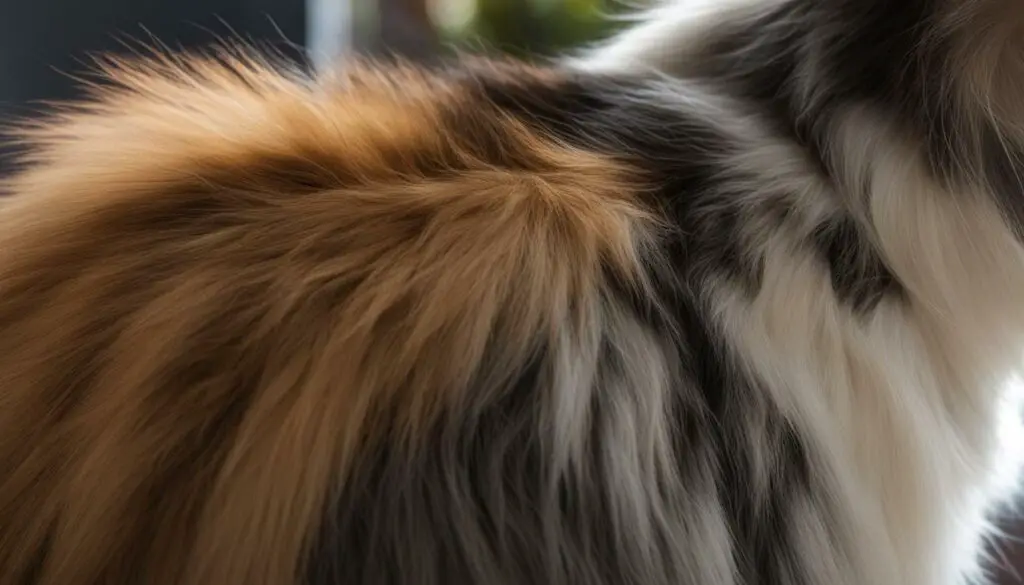As a cat owner, it’s important to understand the intricate details of your feline friend’s communication. One key aspect to decode their messages is their tail base. The cat tail base, consisting of feline anatomy, structure, and communication, holds the secrets to understanding your cat’s emotions, intentions, and needs. By observing and interpreting the movements and positions of their tail, you can deepen your bond and create a harmonious relationship with your furry companion.
Key Takeaways:
- Observing the different movements and positions of your cat’s tail base can help you decipher their messages.
- The cat tail base serves various purposes, including balance, movement, grooming, and communication.
- Understanding the language of the cat tail base enables you to accurately interpret your cat’s mood and intentions.
- Tail movements and positions indicate comfort, social interactions, fear, excitement, stress, scent marking, and more.
- Interpreting tail vibrations requires considering the whole context, including other body language cues and the cat’s unique personality.
The Language of the Cat Tail Base
Cats have a unique and fascinating way of communicating, and their tail base plays a crucial role in conveying their messages. By understanding the language of the cat tail base, pet owners can decipher their furry friend’s emotions and intentions more accurately. Different tail movements and positions carry specific meanings and signals, providing valuable insights into a cat’s state of mind.
One key tail position that indicates a cat’s happiness and confidence is when their tail is held straight up. This signifies contentment and a positive mood. On the other hand, a tail that is whipping back and forth is a clear sign of fear or reactivity. By paying attention to these tail movements, pet owners can better gauge their cat’s emotional well-being and provide the necessary support.
Observing the language of the cat tail base can deepen the bond between pet owners and their furry companions. It allows for more effective communication and enhances the overall understanding of a cat’s needs and desires. By recognizing and interpreting the signals conveyed through the tail base, pet owners can create a harmonious and enriching environment for their beloved cats.
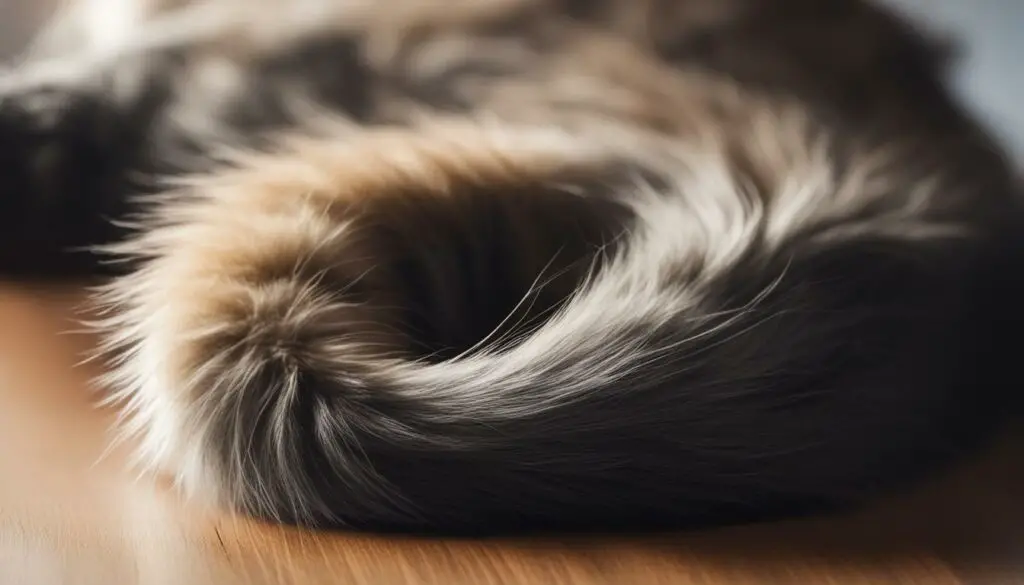
In the following table, we provide a comprehensive overview of the various tail movements and their corresponding meanings:
| Tail Movement | Meaning |
|---|---|
| Straight up | Happiness and confidence |
| Whipping back and forth | Fear or reactivity |
| Slow-moving | Focus and intention |
| Relaxed and held low | Comfort and relaxation |
| Raised back at an angle | Uncertainty |
| Curled with a little curve at the end | Playfulness and friendliness |
| Straight down or between the legs | Reactivity and aggression (in some cases) |
The Language of the Cat Tail Base
The cat’s tail base is an essential component of their communication system. Different tail movements and positions convey specific messages and emotions. For example, a tail held straight up indicates happiness and confidence, while a whipping tail signifies fear or reactivity. Understanding the language of the cat tail base can help pet owners interpret their cat’s mood and intentions accurately.
Decoding Tail Movements
Cats use various tail movements to communicate their emotions and intentions. Understanding the meanings behind these movements can help pet owners interpret their cat’s behavior and respond appropriately. Here are some common tail movements and their meanings:
Tail Pointing Straight Up
When a cat’s tail is pointing straight up, it indicates a happy and friendly cat. This position is often seen when a cat is greeting their owner or other familiar humans or animals. It is a sign of confidence and contentment.
Whipping Tail
If a cat’s tail is whipping back and forth rapidly, it usually signifies fear or reactivity. This movement can indicate that the cat is feeling threatened or uncomfortable in their current environment. It is important to give the cat space and try to identify the source of their distress.
Slow Moving Tail
When a cat’s tail moves slowly from side to side, it indicates focus and intention. This movement is often seen when a cat is preparing to pounce on a toy or engage in play. It is a sign that the cat is fully engaged and ready to spring into action.
By paying attention to these tail movements and their meanings, pet owners can gain valuable insights into their cat’s emotions and needs. It allows for better communication and a stronger bond between cat and owner.

| Tail Movement | Meaning |
|---|---|
| Tail pointing straight up | Happiness and confidence |
| Whipping tail | Fear or reactivity |
| Slow moving tail | Focus and intention |
Understanding and interpreting tail movements is an essential part of understanding a cat’s behavior and needs. By observing and responding to these movements, pet owners can ensure a harmonious and fulfilling relationship with their feline companions.
The Tail as a Sign of Comfort
When it comes to understanding our feline friends, decoding their body language is key. One important aspect of a cat’s body language is the position and movement of their tail. A relaxed and low-held tail is a clear indication of comfort and contentment in cats.
Imagine seeing your cat peacefully curled up, their tail tucked neatly beneath their body. This position is a testament to their level of relaxation and comfort. It’s their way of telling us that they feel safe and secure in their environment.
“A relaxed tail position is like a warm hug from your cat. It shows that they trust you and are happy in your presence,” says Dr. Emily Johnson, a feline behavior expert.
Understanding the significance of a relaxed tail can help us create a peaceful and harmonious living space for our cats. Providing them with cozy resting areas, comfortable bedding, and quiet places to retreat to can contribute to their overall sense of comfort and well-being.
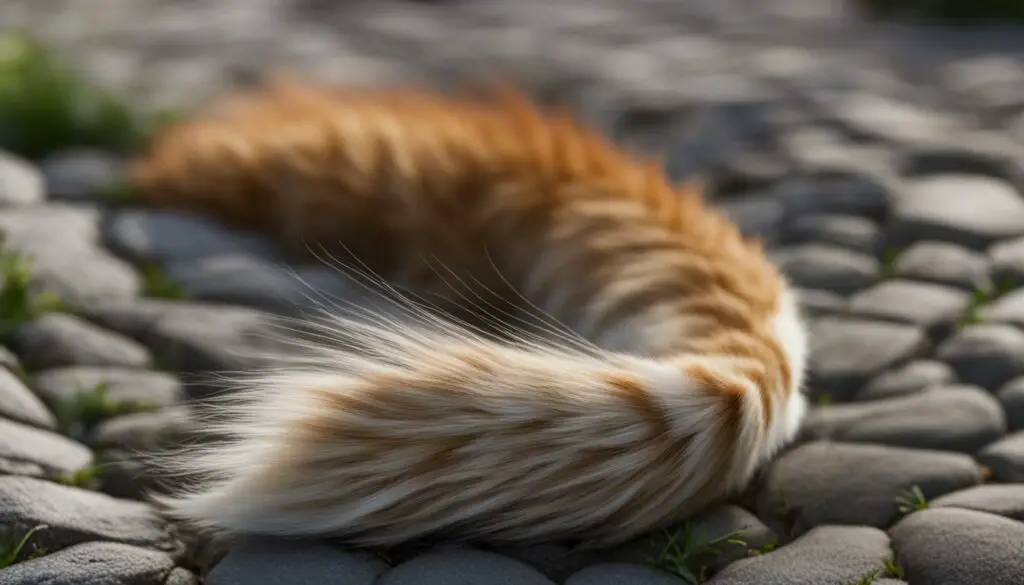
| Tail Position | Meaning |
|---|---|
| Relaxed and low-held | Comfort and contentment |
| Tail tucked beneath body | Deep relaxation |
| Slow, gentle swaying | Peaceful and at ease |
Remember to respect your cat’s personal space and avoid disrupting their peaceful moments when their tail is in a relaxed position. Allow them to come to you for affection and attention, reinforcing their trust and reinforcing the bond between you.
Tail Positions and Social Interactions
Understanding the different tail positions of your cat can provide valuable insights into their social interactions and help strengthen the bond between you and your furry friend. Cat tail base movements are an essential part of their communication system, and by paying attention to these cues, you can engage in interactive playtime and create a deeper sense of connection.
One common tail position that indicates a cat’s willingness to engage is when their tail is raised back at an angle. This gesture is a non-threatening signal, showing the cat’s uncertainty but also their openness to interaction. It’s an invitation for you to approach them and initiate playtime or bonding activities.
Another tail position to look out for is when a cat’s tail is curled with a little curve at the end, resembling a question mark. This position signals playfulness and a friendly mood, indicating that your cat is ready for interactive play and social engagement. It’s the perfect opportunity for you to grab their favorite toy or engage in some quality bonding time.
| Tail Position | Meaning |
|---|---|
| Raised back at an angle | Non-threatening gesture, indicating uncertainty and openness to interaction |
| Curled with a little curve at the end | Signal of playfulness and a friendly mood, expressing readiness for interactive play |
By understanding these tail positions, you can respond appropriately to your cat’s social cues. Engaging in interactive play and bonding activities not only strengthens your relationship but also provides mental and physical stimulation for your cat. So, the next time you see your cat with their tail raised or curled, seize the opportunity to create a joyful and fulfilling experience for both of you.
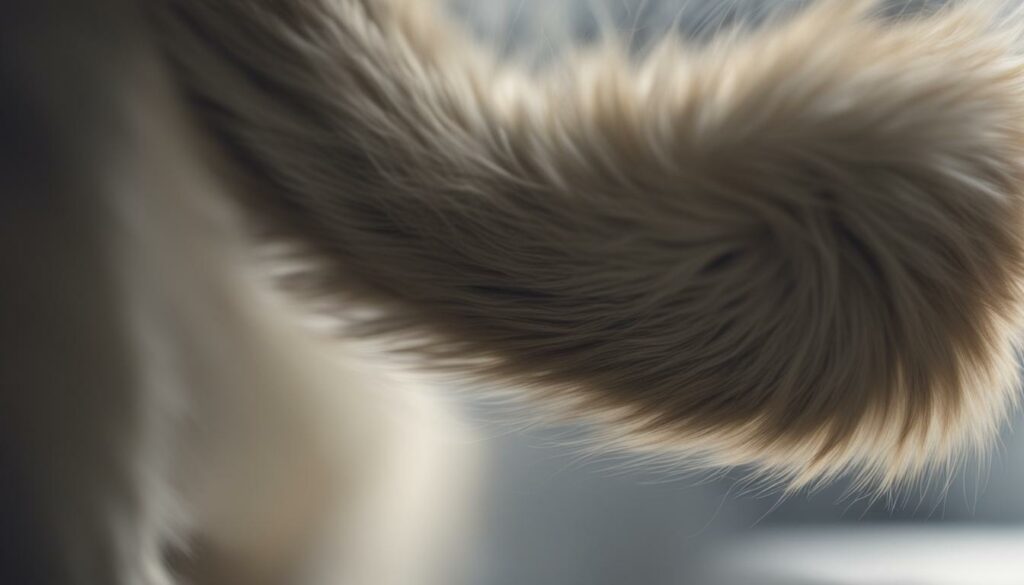
Understanding Fear and Defensive Aggression
When it comes to understanding a cat’s behavior, one of the key aspects to pay attention to is their tail base. The position and movements of a cat’s tail can reveal a lot about their emotions and intentions. In this section, we will explore how the cat tail base can indicate fear and defensive aggression, and how pet owners can interpret these signals.
Cats often express fear and defensive aggression through specific tail positions and movements. A tail held straight down or between the legs is a clear indication of reactivity and an aggressive mood. It’s important to note, however, that some cat breeds, such as Persians, naturally have a low tail carriage, which should not be mistaken for reactive behavior. To accurately interpret a cat’s tail position, it’s essential to observe it in conjunction with other body language cues.
By paying attention to the position of the tail along with other behavioral cues, pet owners can recognize signs of fear or defensive aggression in their cats. This knowledge allows them to create a calm and safe environment for their furry friends, reducing stress and promoting their overall well-being.
| Tail Position | Meaning |
|---|---|
| Straight down or between the legs | Fear or defensive aggression |
| Low tail carriage (for certain breeds like Persians) | Natural tail position |
By observing the position and movements of a cat’s tail base, pet owners can gain valuable insights into their cat’s emotions and respond accordingly. This not only helps prevent potential conflicts and misunderstandings but also strengthens the bond between the cat and their owner.
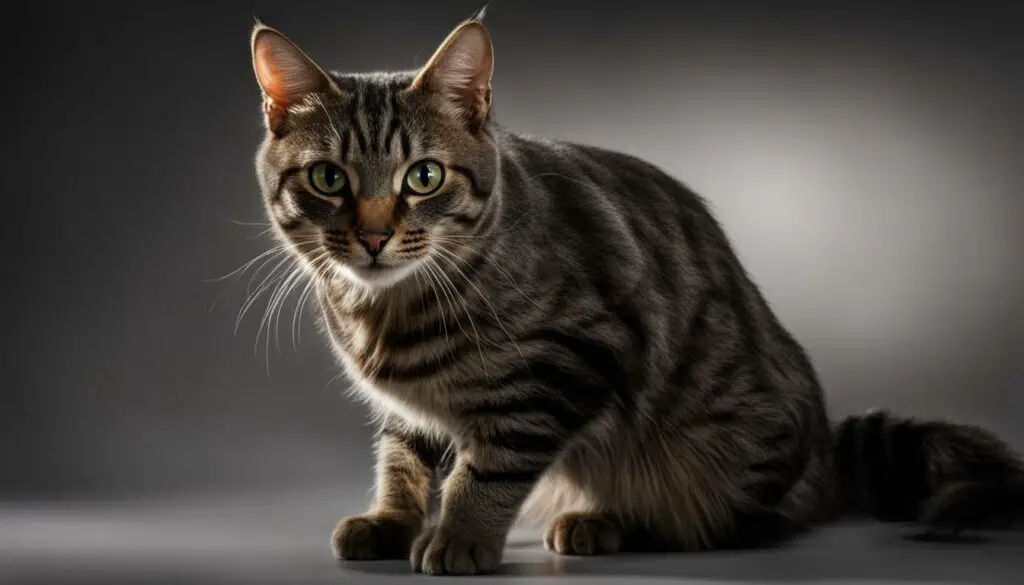
Fear and Defensive Aggression: Body Language Cues to Look for
- Dilated pupils
- Ears flattened backward
- Hissing or growling
- Arched back or puffed-up fur
“Understanding a cat’s tail base is crucial for deciphering their emotions. By paying attention to their tail position and movements, we can provide them with the care and environment they need to feel safe and secure.”
By being attentive to their cat’s tail base, pet owners can better understand their furry friend’s fears and defensive aggression. This knowledge allows for a more harmonious and enriched relationship between cats and their owners.
Tail Movements and Excitement
The movements of a cat’s tail can often reveal their level of excitement and anticipation. Understanding these tail movements can allow pet owners to create a stimulating and enriching environment for their feline companions.
When a cat is excited, their tail may vibrate or twitch with happiness. This tail movement signifies their anticipation of something enjoyable, such as playtime or interaction with their owner. It’s a clear indication that the cat is ready for fun and engagement.
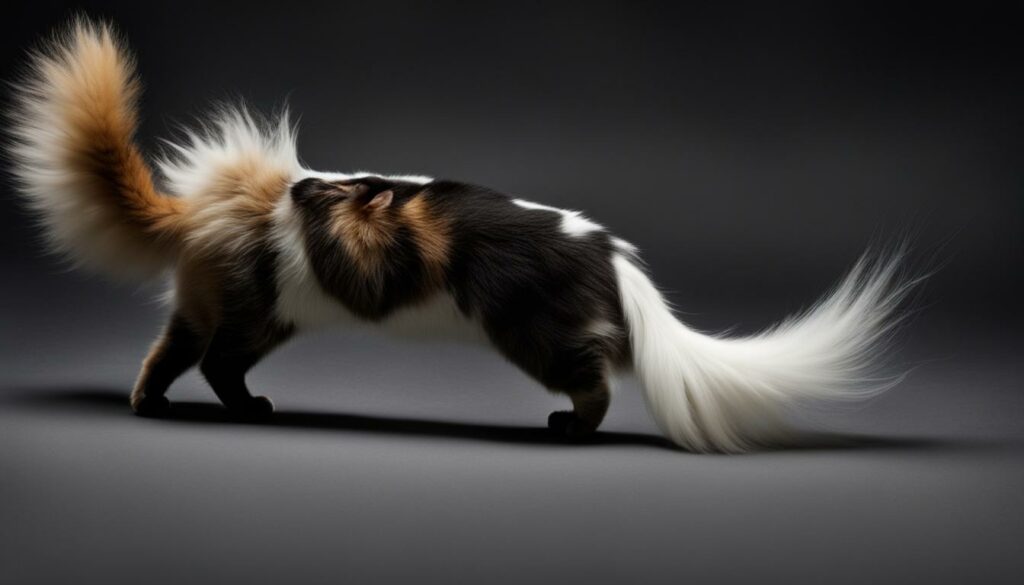
Additionally, tail vibrations can be seen when a cat is getting ready to pounce. The tail may quiver or shake in anticipation of capturing their prey or engaging in a playful chase.
By recognizing these tail movements of excitement and anticipation, pet owners can foster a stimulating environment that keeps their cat engaged and happy. Providing interactive toys and play sessions that channel their cat’s energy can help satisfy their natural instincts and strengthen the bond between them and their feline companion.
Tail Vibrations and Scent Marking
Cats have a unique way of marking their territory and establishing ownership through tail vibrations. These small movements play a significant role in their scent marking behavior. The base of a cat’s tail is home to scent glands, which release pheromones that carry specific messages to other cats in the area. Through tail vibrations, cats can spread their unique scent and communicate important information about their territory.
When a cat rubs their tail against objects or other cats, they are not only leaving their scent behind but also asserting their dominance. This behavior serves as a way for cats to establish boundaries and claim their territory. By understanding this natural instinct, pet owners can create a scent-friendly environment for their cats, allowing them to feel secure and avoid territorial conflicts.
To better illustrate this behavior, here’s a table summarizing the different types of tail vibrations and their associated meanings:
| Tail Vibrations | Meanings |
|---|---|
| Vibrating tail rubbed against objects or other cats | Marking territory and asserting dominance |
| Vibrating tail rubbed against humans | Forming a bond and marking familiarity |
| Vibrating tail during greetings with other cats | Signaling friendliness and establishing relationships |
By recognizing and respecting a cat’s need to scent mark, pet owners can create an environment that supports their natural behaviors and encourages a sense of security and comfort.
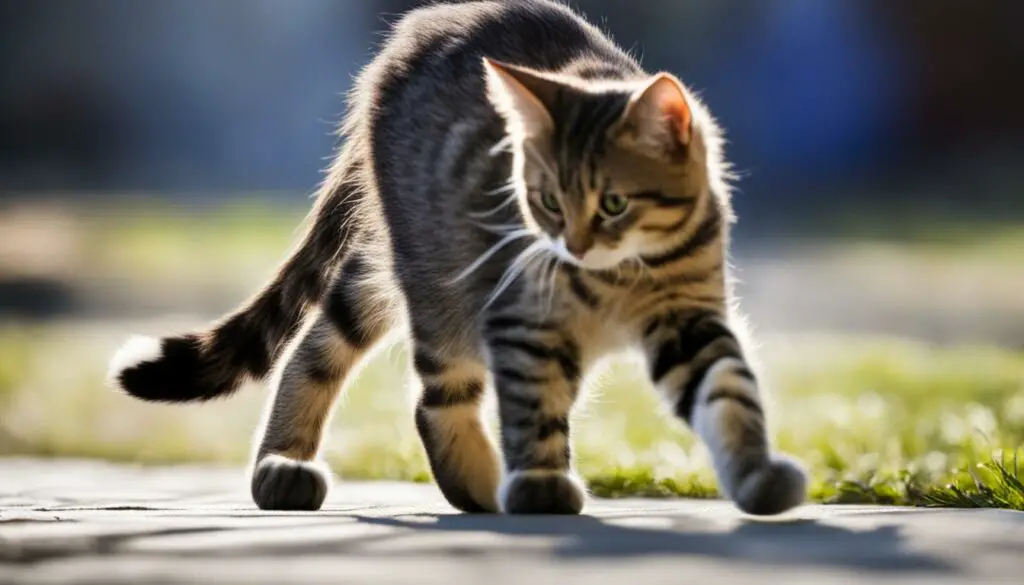
Tail Vibrations and Social Signaling
When it comes to communicating their emotions and building relationships, cats have a unique way of using their tail vibrations. These subtle movements provide important social signals, both to other cats and to humans. By understanding and interpreting these tail vibrations, pet owners can deepen their bond with their feline companions and enhance communication.
One way cats use tail vibrations as a form of social signaling is by entwining their tails with another cat’s tail. This behavior often occurs during friendly encounters and serves as a gesture of companionship and trust. Similarly, when cats rub their tails against humans, it’s their way of showing affection and forming a connection.
“Tail vibrations are a powerful tool for cats to communicate and build relationships. By paying attention to these subtle movements, pet owners can strengthen their bond with their feline friends.”
Understanding these social signaling behaviors can help pet owners respond appropriately and nurture their cat’s social needs. Engaging in interactive play and allowing cats to initiate tail-related interactions can create a positive and enriching environment for both the pet and the owner.
In conclusion, tail vibrations play a significant role in cat communication and social signaling. By recognizing and interpreting these subtle movements, pet owners can better understand their cat’s emotions and strengthen their bond. Tail awareness is key to effective communication and can foster a harmonious relationship between cats and their owners.
| Benefits of Tail Vibrations in Cat Communication | How to Enhance Social Signaling |
|---|---|
|
|
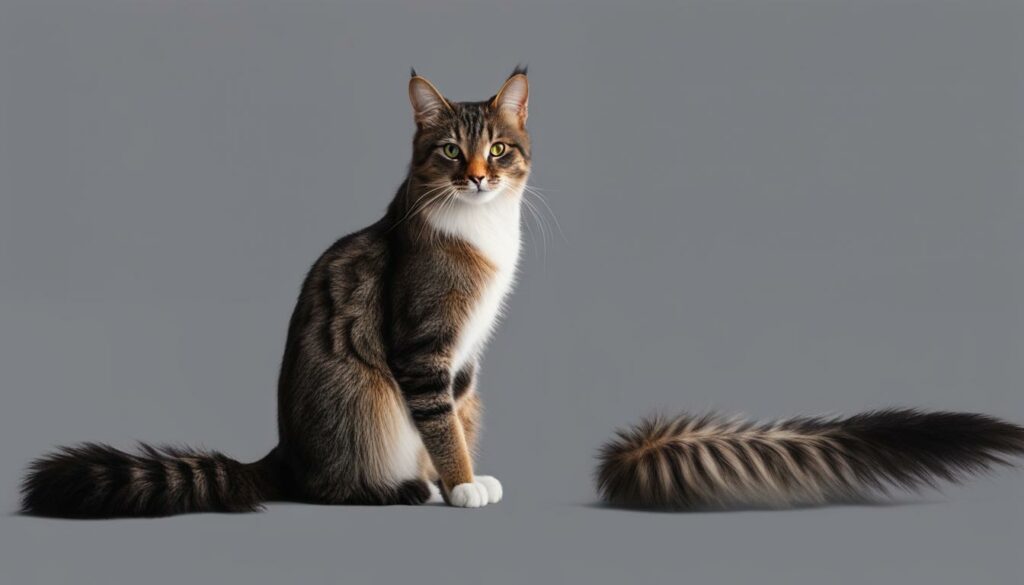
Tail Vibrations and Stress
As cat owners, it’s essential to understand that tail vibrations can be an indicator of stress or anxiety in our feline friends. When a cat feels threatened or frightened, their tail may start to shake or quiver, reflecting their inner discomfort. This behavior is a clear signal that your cat is experiencing some level of stress and needs your support and care.
Recognizing these tail vibrations is crucial for creating a calm and safe environment for your cat. By doing so, you can help alleviate their stress and anxiety, promoting their overall well-being. Providing a peaceful space with minimal triggers and disturbances can go a long way in helping your cat relax and feel safe.
It’s important to remember that each cat is unique, and their response to stress may vary. While tail vibrations can indicate anxiety in general, it’s equally important to consider other body language cues and your cat’s overall behavior. Understanding your cat’s individual personality and tail language will enable you to accurately interpret their emotional state and respond accordingly.

By being attuned to your cat’s tail vibrations, you can address their stress and anxiety effectively, providing the care and support they need. Remember, a calm and safe environment not only promotes a healthier lifestyle for your cat but also strengthens the bond between you and your feline companion.
The Science Behind Tail Vibrations
Understanding the science behind tail vibrations can provide valuable insights into a cat’s behavior. The tail base of a cat is rich in nerve endings, which play a crucial role in communication and expression. These nerve endings allow cats to react through various tail movements, indicating their emotions and intentions. The anatomy of the tail base is composed of vertebrae, muscles, and nerves, all working together to facilitate tail vibrations.
The nervous system also plays a significant role in tail vibrations. The sympathetic and parasympathetic nervous systems are involved in regulating a cat’s emotional state and physical responses. Tail vibrations can indicate emotions such as anxiety or relaxation, as these systems are interconnected with the cat’s overall well-being. By observing tail vibrations, pet owners can gain insights into their cat’s emotional state and provide appropriate support and care.
To summarize, tail vibrations in cats have scientific explanations rooted in their anatomy and nervous system. Understanding the scientific aspects of tail vibrations can deepen our understanding of a cat’s behavior. By recognizing the significance of tail vibrations, pet owners can enhance their communication with their feline companions and provide a nurturing environment that promotes their well-being.

Table: Common Tail Vibrations and their Meanings
| Tail Vibration | Meaning |
|---|---|
| Rapid, gentle vibration | Contentment and relaxation |
| Fast, erratic vibration | Excitement or anticipation |
| Slow, rhythmic vibration | Anxiety or stress |
| Intense, rapid vibration | Aggression or irritation |
Interpreting Tail Vibrations
When it comes to understanding our feline friends, interpreting their tail vibrations is a crucial part of deciphering their body language. Tail vibrations can provide valuable insights into a cat’s emotional state, but it’s important to observe the context and consider other body language cues to accurately interpret their signals.
The position of a cat’s tail and the way it vibrates can convey a range of emotions and intentions. For example, a fast and vigorous tail wag can indicate excitement or anticipation, while a slow and subtle vibration may be a sign of contentment or relaxation.
However, it’s essential to remember that each cat has their own unique tail language. What may be interpreted as excitement in one cat might signify stress or fear in another. The key is to get to know your individual cat and observe their tail vibrations in different situations to understand their personalized communication style.
By paying attention to tail vibrations, along with other behavioral cues, we can gain a deeper understanding of our cats’ needs and emotions. This knowledge allows us to respond appropriately, creating a harmonious environment and strengthening the bond we share with our furry companions.
Strengthening the Bond Through Tail Awareness
Understanding and observing the subtle movements and positions of a cat’s tail base can have a profound impact on the bond between pet owners and their feline friends. By paying attention to the language of tail communication, we can enhance our understanding of our cats’ needs, emotions, and desires. Developing tail awareness promotes effective communication and creates a harmonious living environment that nurtures the unique relationship shared between cats and their owners.
When we observe the tail movements and positions of our cats, we gain valuable insights into their emotional states. A cat with a tail held straight up signals happiness and confidence, while a whipping tail indicates fear or reactivity. Recognizing these signs allows us to respond appropriately and provide comfort and support when needed. By understanding our cats’ tail language, we can strengthen our bond, build trust, and ensure their well-being.
Tail awareness also enables us to engage in interactive play and strengthen our relationship. A tail raised back at an angle signifies a non-threatening gesture, inviting social interaction. A curled tail resembling a question mark signals playfulness and a friendly mood. By recognizing these tail positions, we can actively participate in playtime, bond with our cats, and create joyful memories together.
Ultimately, tail awareness deepens our connection with our cats and fosters a loving and respectful relationship. By understanding and interpreting the nuances of their tail movements and positions, we can respond to their needs more effectively, provide a stimulating and comforting environment, and ensure their overall happiness and well-being. The cat tail base is a powerful tool for communication, and by embracing tail awareness, we can nurture a bond that will last a lifetime.
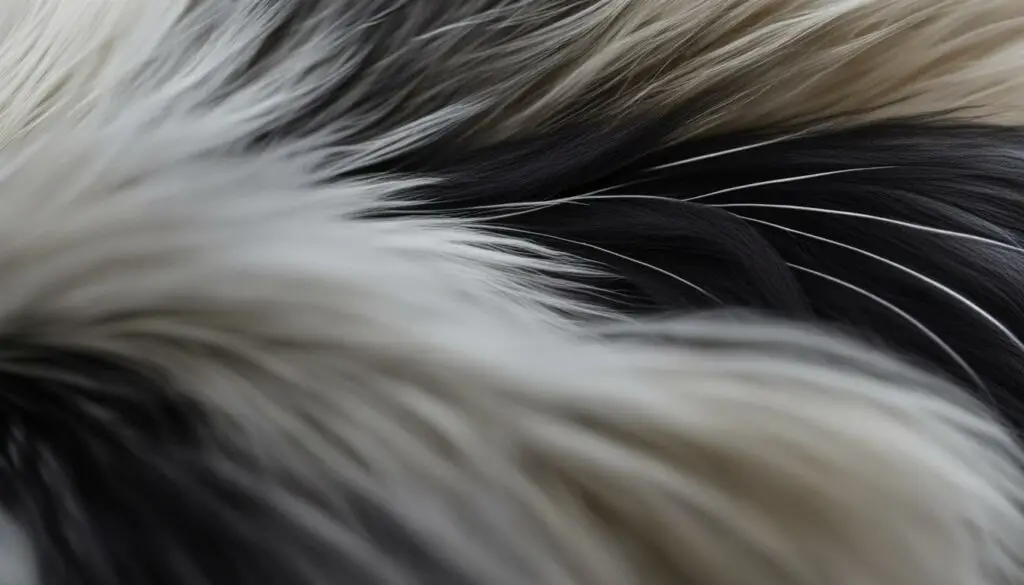
| Benefits of Tail Awareness | Examples |
|---|---|
| Enhanced communication | Recognizing the difference between a happy and fearful tail position. |
| Strengthened bond | Engaging in interactive play based on tail positions that signify playfulness. |
| Improved well-being | Responding appropriately to tail signals of comfort, relaxation, or stress. |
Conclusion
Understanding the secrets of the cat tail base is essential for deepening the bond between you and your feline friend. By paying attention to their tail movements and positions, you can unlock the mysteries of their behavior and ensure their well-being.
Observing the language of the cat tail base allows you to interpret their emotions and intentions accurately. Whether it’s a tail held straight up in happiness or a whipping tail signaling fear, understanding these messages promotes effective communication.
By responding appropriately to their needs and providing a stimulating and comforting environment, you can strengthen your relationship with your cat. Remember, each cat has their own unique tail language, so getting to know their individual style of communication is key.
So, embrace tail awareness and nurture the unique relationship you share with your cat. The cat tail base holds the secrets to understanding, connecting, and building a harmonious life together.
FAQ
How can I understand my cat’s tail movements?
By observing and interpreting the different movements and positions of your cat’s tail, you can decipher their messages and understand their mood and intentions.
What does it mean when a cat’s tail is held straight up?
A tail held straight up indicates that the cat is happy and confident.
What does it mean when a cat’s tail is whipping back and forth?
A whipping tail signifies fear or reactivity in the cat.
What does it mean when a cat’s tail is low and relaxed?
When a cat’s tail is relaxed and held low, it signifies comfort and relaxation.
How can I tell if my cat wants to engage in social interactions?
A cat with a tail raised back at an angle is signaling uncertainty, while a tail curled with a little curve at the end resembling a question mark indicates playfulness and a friendly mood.
How can I recognize signs of fear or defensive aggression in my cat’s tail?
A tail held straight down or between the legs indicates reactivity and an aggressive mood. However, certain cat breeds naturally have a low tail carriage, which should not be confused with reactive behavior.
What do tail vibrations signify in cats?
Tail vibrations in cats are often signs of excitement, anticipation, or stress. They can indicate happiness, readiness for play, or anxiety, depending on the context.
Why do cats vibrate their tails against objects or other cats?
Cats vibrate their tails as a way to spread their scent markings and establish their territory or ownership.
How do cats use tail vibrations for social signaling?
Cats use tail movements, such as entwining their tails with another cat’s tail or rubbing their tails against humans, to indicate friendliness and build relationships.
What does it mean if my cat’s tail is shaking?
Tail shaking in cats can indicate stress or anxiety, especially when they feel threatened or frightened.
What is the science behind tail vibrations in cats?
Tail vibrations are a result of the anatomy and nervous system of cats. The tail base is rich in nerve endings, and the sympathetic and parasympathetic nervous systems play a role in tail movements and emotions.
How can I interpret tail vibrations accurately?
Interpreting tail vibrations requires observing the context, considering other body language cues, and understanding your cat’s unique personality. Each cat may have its own tail language and communication style.
How can I strengthen the bond with my cat through tail awareness?
By understanding and observing the nuances of your cat’s tail base, you can respond appropriately to their needs and emotions, enhancing communication and creating a harmonious living environment.
What can I gain from understanding the secrets of the cat tail base?
Understanding the cat tail base allows you to unlock the mysteries of your cat’s behavior, deepen the bond between you and your feline friend, and nurture a unique relationship based on effective communication and understanding.

